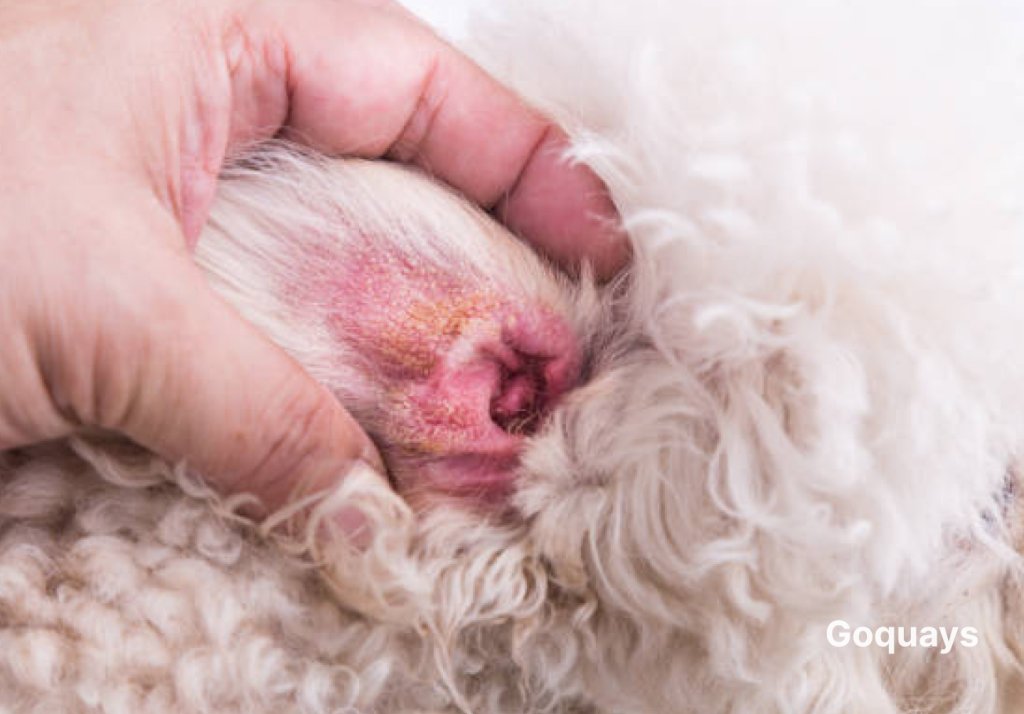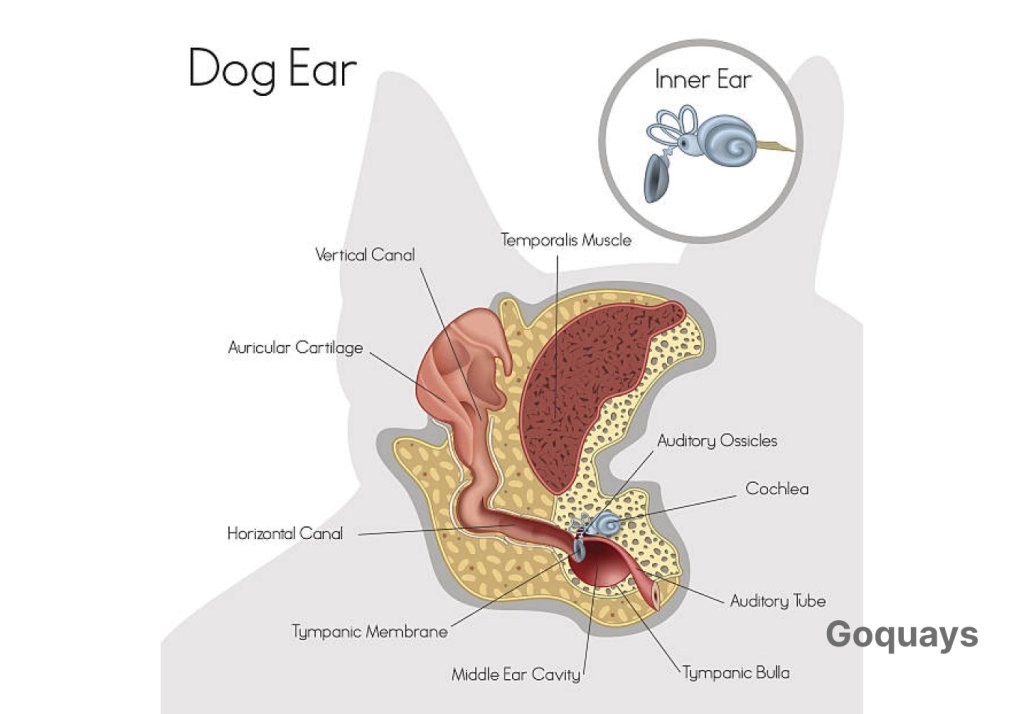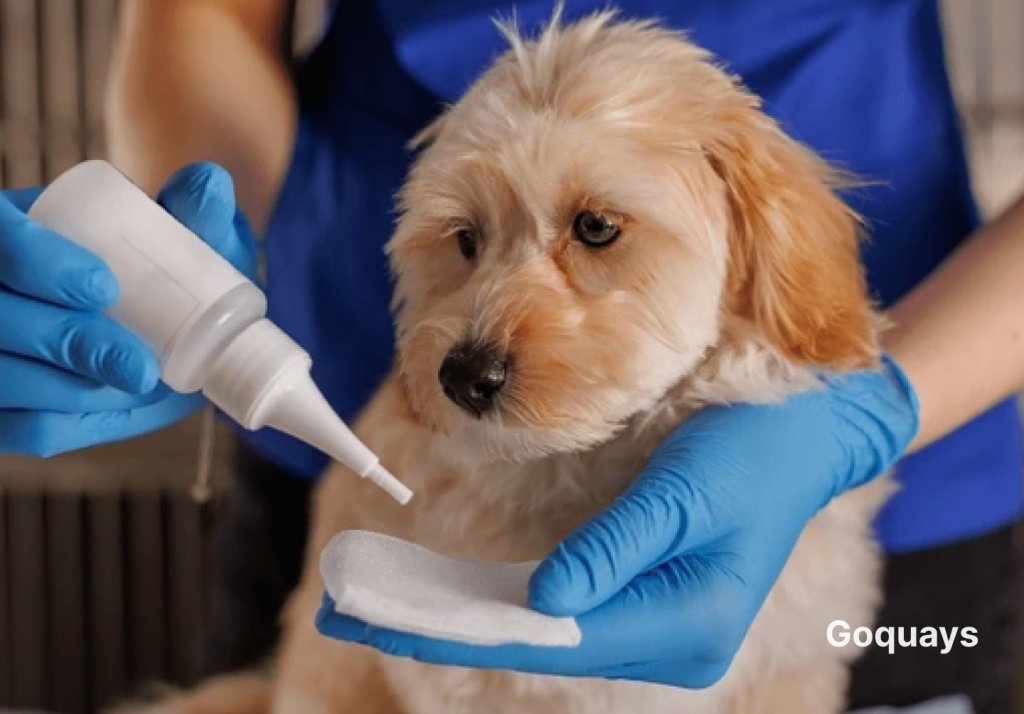Dog ear infections are more common than you might think. If your dog has ever scratched their ear a little too much, shaken their head constantly, or seemed uncomfortable, an ear infection might be the reason. These infections can happen quickly and cause a lot of pain if not caught early.
You might notice a strange smell coming from your dog’s ear, or you could see redness and swelling when you take a closer look. Some dogs even cry out in pain when you touch their ears. It can be upsetting to see your dog suffer, especially when ear infections can sometimes lead to more serious health problems if left untreated.
Understanding what causes ear infections and knowing the warning signs can make a huge difference for your dog’s comfort and health. Different things like bacteria, yeast, allergies, and even trapped moisture after a swim can all trigger an infection. Some breeds with floppy ears or lots of hair inside their ears are more at risk too.
The good news is that most ear infections are easy to treat if you act fast. Treatments can range from simple ear drops to oral medications, depending on how bad the infection is. In rare cases, surgery might be needed, but most dogs recover quickly with the right care.
In this guide, you’ll learn everything you need to know about dog ear infections. We’ll walk you through the symptoms, causes, treatment options, and easy tips for preventing future problems. You’ll also find answers to the most common questions dog owners ask about ear infections. By the end, you’ll be ready to help keep your dog’s ears healthy and pain-free.
What is a Dog Ear Infection?

Dog ear infections happen when parts of the ear become inflamed or infected. It might involve the external ear, middle ear, or even the inner ear. Each part plays a different role in helping your dog hear and balance, so problems in any area can cause serious discomfort.
Most of the time, infections start in the external ear canal. This area is exposed to moisture, dirt, and bacteria, making it a common trouble spot. If left untreated, the infection can move deeper into the middle or inner ear, causing more pain and bigger health issues.
You might not always notice an ear infection right away. Early signs can be mild, like scratching or head shaking. But as the infection gets worse, your dog might show more obvious symptoms like swelling, redness, bad smells, or even changes in balance.
Ear infections can be caused by many things. Allergies, bacteria, yeast, trapped water, or even something stuck inside the ear can trigger them. Certain breeds with floppy ears or lots of hair inside the ear canal are more likely to develop infections because their ears trap more moisture and dirt.
The good news is that most ear infections are treatable once you spot them. With the right care and attention, your dog can bounce back quickly and feel much better. Early diagnosis and treatment are important to stop infections from becoming more serious.
In short, a dog ear infection is any inflammation or infection in the ear that causes discomfort, pain, or other symptoms. Knowing what to look for can help you catch problems early and keep your dog’s ears clean, healthy, and happy.
Symptoms of Dog Ear Infections

When your dog has an ear infection, the signs can be pretty easy to spot once you know what to look for.
- Head shaking or tilting: One of the first things you might notice is head shaking or tilting. Your dog might shake their head often, trying to ease the irritation inside the ear.
- Scratching at the ear or around the ear: Scratching is another big clue. If your dog keeps pawing at their ear or rubbing it against furniture, it could mean they are uncomfortable.
- Redness inside the ear: Take a peek inside the ear. If you see redness or swelling, it’s often a sign that something isn’t right. Healthy ears should look clean and pale pink, not angry or inflamed.
- Odor from the ear: A bad smell coming from the ear is a major red flag. Infections often cause a strong, foul odor that is hard to miss.
- Discharge (yellow, brown, or bloody): You might also notice some discharge. It could be yellow, brown, or even bloody. Any kind of unusual fluid should get checked by your vet.
- Crusting or scabs in the ear
Sometimes infections cause crusting or scabs inside or around the ear. This happens when your dog scratches too much or when the infection damages the skin. - Signs of hearing loss or balance issues: In more serious cases, you might see signs of hearing loss or balance problems. Your dog could seem clumsy, disoriented, or slow to respond to sounds.
Each dog shows symptoms differently, and the severity can vary a lot. Some infections are mild and easy to treat. Others can get painful and serious if ignored.
Types of Ear Infections in Dogs

Dogs can suffer from different types of ear infections, depending on which part of the ear is affected. Each type can cause discomfort, but knowing the difference helps you catch problems early and get the right treatment.
- Otitis Externa: This is the most common type of ear infection in dogs. It affects the external part of the ear, basically the ear canal leading to the eardrum. Otitis externa often happens when bacteria, yeast, or even ear mites cause irritation. Dogs with floppy ears or lots of hair in their ear canals are more prone to this infection because moisture and debris get trapped easily.
- Otitis Media: Otitis media is an infection of the middle ear, which sits just behind the eardrum. It usually develops when an outer ear infection goes untreated and spreads deeper. Dogs with otitis media might show more severe signs like balance problems, head tilting, or even facial nerve issues. In some cases, a ruptured eardrum allows bacteria to move into the middle ear, making the infection harder to treat.
- Otitis Interna: This is the most serious type of ear infection. It affects the inner ear, where important structures for hearing and balance are located. Otitis interna can cause severe symptoms like loss of balance, vomiting, walking in circles, and even deafness if not treated quickly. It often starts as an external or middle ear infection that worsens over time.
Recognizing which type of ear infection your dog might have is important because it affects how treatment will be handled. A vet can diagnose the exact problem through an ear exam and sometimes imaging tests if the infection seems deep or chronic.
Getting early treatment for any ear infection helps prevent complications and keeps your dog feeling their best.
What’s the Difference Between a Dog Yeast Ear Infection vs. Bacterial Infection?

Dog ear infections are not all the same. Two of the most common types are yeast infections and bacterial infections. While both cause discomfort, there are key differences you should know.
A yeast ear infection usually smells quite strong, often like something sour or musty. It tends to be chronic, meaning it sticks around and keeps coming back if not managed properly. Yeast infections often cause thick, dark brown, or black discharge. Your dog might scratch a lot and shake their head because the ears are itchy. Yeast thrives in warm, moist environments, making dogs with floppy ears or allergies more at risk.
On the other hand, a bacterial ear infection can appear very suddenly. It tends to be more painful for your dog compared to yeast infections. Bacterial infections often produce yellow, green, or bloody pus from the ear. You might also notice swelling, redness, and a bad odor. Some bacterial infections are mild, while others can become very serious if left untreated.
One way to tell the difference is by the smell and discharge, but only a vet can confirm exactly what’s going on. Sometimes, dogs can even have both yeast and bacterial infections at the same time. That’s why getting a proper diagnosis is so important before starting any treatment.
Knowing whether your dog’s ear infection is caused by yeast or bacteria helps ensure they get the right medication and heal faster.
Dog ear infections usually do not happen without a reason. Several causes can trigger inflammation and infection inside a dog’s ears.
Causes of Ear Infections in Dogs
One of the most common causes is bacteria. When bacteria grow out of control, they can quickly lead to painful infections. Yeast is another common cause, especially in dogs who have allergies or spend a lot of time in water.
Ear mites can also cause infections, especially in puppies or dogs who spend time around other animals. These tiny parasites are irritating and cause intense scratching, which can open the door for further infection.
Allergies—both food and environmental—often lead to chronic ear issues. If your dog is allergic to pollen, dust mites, or certain foods, their ears might become inflamed, making it easier for infections to set in.
Foreign objects like grass seeds, dirt, or small twigs can get trapped in the ear canal. This causes irritation and eventually leads to infection if not removed quickly.
Dogs with excess moisture in their ears, like frequent swimmers, are also at risk. Wet ears create the perfect breeding ground for bacteria and yeast.
Injuries to the ear, such as scratches from rough play, can break the skin and allow infections to start. Also, hormonal issues like hypothyroidism can make dogs more prone to ear infections.
Finally, the shape of the ear matters. Dogs with long, floppy ears like Basset Hounds and Cocker Spaniels often have poorer airflow, making it easier for moisture and debris to build up.
Understanding what causes ear infections in dogs helps you spot problems early and take steps to prevent them.
How Veterinarians Diagnose Dog Ear Infections

When you bring your dog to the vet for a suspected ear infection, the first step is a thorough physical exam. Your vet will look closely at the ear canal and the outer ear, checking for redness, swelling, discharge, and foul odor. They may also ask about your dog’s symptoms and any changes in behavior.
Next, they usually use a tool called an otoscope. This instrument helps the vet see deep inside your dog’s ear canal. It allows them to spot any blockages, foreign objects, or damage that might not be visible from the outside.
In many cases, the vet will take a sample of the material from your dog’s ear. This is called an ear swab. The swab is examined under a microscope in a test called cytology. It helps identify if bacteria, yeast, or ear mites are present and what type of infection your dog has.
If the infection seems severe or is not responding to treatment, your vet might recommend ear cultures. This test tells exactly which bacteria are causing the infection and which medications will work best.
Sometimes, if the infection has spread deeper or if there’s concern about the middle or inner ear, the vet might suggest imaging tests. X-rays, CT scans, or MRIs can show problems that aren’t visible during a basic exam.
Diagnosing an ear infection properly ensures that your dog gets the right treatment the first time. Quick and accurate diagnosis can make a big difference in how fast your dog recovers.
Once the tests are complete, the vet will share the results and recommend a treatment plan. This could include medications like antibiotics or antifungals, ear cleaning instructions, or possibly steroids if inflammation is present. Your vet will also discuss follow-up visits to ensure your dog’s ear condition is improving and will guide you on preventive measures to avoid future ear problems.
Dog Ear Infection Treatment

Treating a dog ear infection depends on the cause and severity, but quick action always helps recovery. Your vet will usually clean your dog’s ear thoroughly to remove debris, wax, and discharge. Cleaning helps medications work better.
For mild to moderate infections, the vet may prescribe topical treatments. These include ear drops or ointments that contain antibiotics, antifungals, or anti-inflammatory drugs. You’ll need to apply them directly into your dog’s ear once or twice a day.
In some cases, oral medications like antibiotics, antifungals, or steroids are needed. Oral medicine is usually given when the infection is deeper or when the ear is too painful to touch. If your dog is scratching a lot or showing signs of pain, oral medications can also help relieve discomfort.
If the infection is severe or keeps coming back, surgery might be necessary. Surgical treatment can involve procedures to remove growths, open up the ear canal, or even reconstruct parts of the ear. Surgery is rare but sometimes the best option for long-term health.
You should never try home remedies without talking to your vet first. Some treatments you find online can actually make infections worse. Always follow your vet’s instructions carefully and complete the full course of medication, even if your dog seems better.
Routine checkups during treatment are also important. Your vet might want to recheck your dog’s ears after a few weeks to make sure the infection is gone. Skipping follow-up visits could lead to chronic issues.
The good news is, with the right care and a little patience, most dog ear infections clear up quickly.
How to Prevent Dog Ear Infections

Keeping your dog’s ears healthy is easier than treating an infection. A little routine care goes a long way in prevention.
- Clean your dog’s ears regularly: Use a vet-recommended ear cleaner once or twice a week. Gently wipe the visible part of the ear with cotton wool. Avoid using cotton swabs deep inside the ear, as they can push debris further in.
- Dry ears after baths and swimming: Moisture creates the perfect environment for bacteria and yeast. Always dry your dog’s ears with a soft towel after they swim or get a bath. Some dogs may also benefit from drying drops.
- Check ears often for early signs: Take a few minutes every week to inspect your dog’s ears. Look for redness, swelling, unusual odors, or any discharge. Early spotting means easier and quicker treatment.
- Manage your dog’s allergies: Allergies can trigger ear inflammation. Common triggers include certain foods, pollen, and dust mites. Talk to your vet if you notice your dog scratching a lot or showing seasonal flare-ups.
- Keep ear hair trimmed: Dogs with hairy inner ears might trap dirt and moisture more easily. Regularly trimming ear hair can improve airflow. Always ask your vet before deciding to pluck ear hair, as this can sometimes cause irritation.
- Feed a balanced, healthy diet: A strong immune system helps your dog fight off infections. High-quality foods rich in omega-3 fatty acids and antioxidants can make a real difference.
7. Schedule regular vet checkups: Routine vet visits allow professionals to spot problems early. Your vet can perform deep ear cleanings or recommend preventive treatments if your dog is prone to ear infections.
Can a dog ear infection heal itself?
A dog ear infection almost never heals on its own. In fact, ignoring it usually makes the problem worse over time. Most infections are caused by bacteria, yeast, or parasites, all of which thrive in a moist, warm ear canal. Once these organisms take hold, they tend to multiply quickly.
You might notice mild symptoms at first, like slight scratching or head shaking. Without treatment, however, the infection can spread deeper into the ear. This can lead to more serious problems like inner ear infections, balance issues, and even permanent hearing loss.
Another reason ear infections don’t heal themselves is because dogs often make them worse. When a dog scratches an irritated ear or shakes their head violently, they can damage the ear canal or burst blood vessels, creating even bigger problems.
Early veterinary treatment can make all the difference. Your vet will examine the ear, determine the type of infection, and prescribe the right medication. This usually involves topical ear drops, oral antibiotics, or antifungal treatments.
Home remedies and waiting it out are not safe options. Without proper diagnosis and targeted care, you risk serious damage to your dog’s ears.
If you suspect your dog has an ear infection, it’s important to act quickly. Prompt care will relieve your dog’s discomfort faster and help avoid long-term complications. Your dog depends on you to recognize when something isn’t right.
Always trust your instincts. If your dog is scratching, tilting their head, or their ear smells bad, don’t wait. Book a vet appointment and get the right treatment started.
What happens if a dog’s ear infection goes untreated?
Leaving a dog ear infection untreated can cause serious long-term problems. At first, the infection may seem mild—maybe just a little scratching or head shaking. But over time, it can become much worse.
As the infection grows, it can spread from the outer ear to the middle or even the inner ear. This can lead to intense pain, swelling, and serious damage inside the ear canal. Chronic infections can cause thickening of the ear tissue, making it even harder for medications to work later.
Untreated ear infections can also cause hearing loss. As the infection damages the sensitive structures of the ear, your dog may gradually lose their ability to hear. In severe cases, dogs can experience balance problems, dizziness, or even permanent head tilting.
Another big risk is that an untreated infection can rupture the eardrum. Once the eardrum is damaged, the infection can travel deeper into the skull, putting the brain at risk. This can lead to life-threatening conditions like meningitis.
The longer you wait, the harder and more expensive it becomes to treat. Chronic infections often require more aggressive treatments like deep ear flushing under anesthesia or even surgery to remove damaged tissue.
Your dog will also suffer unnecessarily. Ear infections are extremely painful, and your dog may experience constant discomfort, sleeplessness, and stress.
If you notice signs of an ear infection, it’s important to seek veterinary care right away. Early treatment can clear up most infections easily, while delayed treatment can create problems that last a lifetime.
Always take ear problems seriously. Acting quickly protects your dog’s health, happiness, and hearing.
Can a dog ear infection spread to a dog’s brain?
Yes, in rare and severe cases, an untreated dog ear infection can spread to the brain. This is most common with infections that reach the inner ear, known as otitis interna. The inner ear is very close to the brain, and if an infection is left untreated or becomes chronic, it can spread through the ear structures into the skull.
When the infection reaches the inner ear, it can cause more than just discomfort. The deeper tissues of the ear, including the inner structures responsible for hearing and balance, become inflamed and can be damaged. If the infection spreads beyond the ear canal, it may reach the brain, resulting in a serious condition called meningitis or brain abscesses.
Meningitis is an inflammation of the protective membranes surrounding the brain and spinal cord. It can cause severe symptoms, including seizures, loss of coordination, difficulty walking, lethargy, or even paralysis. Brain abscesses are localized pockets of infection in the brain tissue, which can result in similar neurological symptoms, including confusion, behavioral changes, and loss of motor control.
Infection spreading to the brain is a life-threatening emergency. The best way to avoid this is by seeking veterinary care as soon as you notice any symptoms of an ear infection. Early intervention with medications or topical treatments can clear up most ear infections before they become severe.
If your dog shows any signs of a deep ear infection—like persistent head tilting, trouble balancing, or abnormal behavior—immediately contact your vet. Quick action will reduce the risk of complications like brain infections and ensure that your dog stays healthy and comfortable.
Are dog ear infections contagious?
Generally, dog ear infections are not contagious in the way human infections spread, but there are exceptions. Ear infections caused by bacteria, yeast, or allergies typically don’t spread between dogs. However, ear infections caused by parasites, like ear mites, can be contagious, as they can transfer from one dog to another through direct contact.
Ear mites are tiny parasites that live in the ear canal, causing irritation, itching, and inflammation. They are more commonly found in puppies or dogs living in environments with high parasite exposure, like shelters or kennels. These mites can easily spread when dogs come into close contact with each other, especially when they share bedding, toys, or grooming tools.
If you notice one dog scratching at their ears more frequently or shaking their head, and another dog in the same household is experiencing similar symptoms, it’s possible that ear mites could be the culprit. In such cases, both dogs should be examined by a vet, who can prescribe the proper treatment to eliminate the parasites.
Bacterial and yeast ear infections, on the other hand, aren’t typically spread through contact. These infections are usually a result of an underlying issue, like allergies, moisture, or an injury. They aren’t transmitted to other dogs but can recur in the same dog if the primary cause isn’t addressed.
To keep your pets safe, it’s essential to keep their living environment clean and ensure they don’t share items like food bowls or toys if one dog is infected with ear mites. Regular vet check-ups and early intervention can also help prevent infections from becoming a serious problem.
How often should I clean my dog’s ears?
When it comes to cleaning your dog’s ears, less is more. You should only clean your dog’s ears when necessary or as recommended by your vet. Over-cleaning can irritate the ear canal, which might lead to infections or other ear issues. However, if your dog is prone to ear infections or has a history of build-up, regular cleaning can help prevent problems.
For most dogs, a monthly ear cleaning is sufficient. If your dog swims frequently, has floppy ears, or has a tendency to accumulate ear wax, you may need to clean their ears more often—perhaps every two weeks or even weekly in some cases. The key is to monitor your dog’s ears for any signs of discomfort, such as scratching, head shaking, or foul odor, as these may indicate an infection or excess build-up.
It’s important to use a vet-approved ear cleaning solution and avoid using cotton swabs, which can push dirt deeper into the ear canal. You can clean the outer part of the ear flap with a soft cotton ball or pad soaked in the ear cleaner. Be gentle and avoid inserting anything into the ear canal itself. If your dog shows signs of pain or discomfort during cleaning, or if you’re unsure about how to do it safely, it’s best to consult with your vet.
What breeds are most prone to ear infections?
Some dog breeds are more prone to ear infections due to their physical characteristics, such as the shape of their ears or the amount of moisture they retain. Dogs with floppy ears or hairy ear canals are especially vulnerable. These breeds often trap moisture, wax, and debris, creating an environment that can lead to infections.
Here are a few breeds most prone to ear infections:
- Cocker Spaniels – Their long, floppy ears can trap moisture and debris, increasing the risk of ear infections.
- Basset Hounds – With their droopy ears and oily skin, Basset Hounds are particularly prone to ear issues.
- Golden Retrievers – Their thick, water-resistant coat and floppy ears make them prone to trapping moisture in the ear canal.
- Labrador Retrievers – Like Golden Retrievers, they have floppy ears and often swim, leading to higher moisture retention in the ears.
- Poodles – The dense hair in their ear canal can block airflow and trap moisture, leading to infections.
- Shih Tzus – Their long hair can cause build-up in the ears, making them susceptible to infections.
In addition to the ear shape, dogs with allergies, chronic skin conditions, or those exposed to frequent moisture (e.g., swimming or bathing) are also at a higher risk of ear infections. Regular ear checks, cleaning, and vet visits can help manage the risk of infections in these breeds.
Conclusion
Ear infections in dogs are more common than you might think, but with the right knowledge, you can protect your pet from discomfort and long-term issues. Recognizing the symptoms early, such as head shaking, redness, or foul odor, is key to getting prompt treatment. Whether the cause is yeast, bacteria, allergies, or moisture, timely intervention can prevent the infection from worsening and leading to chronic conditions or hearing loss.
While certain breeds are more prone to ear infections due to their ear shape or lifestyle, all dogs can benefit from regular ear checks and proper care. Preventative measures like keeping ears dry, avoiding over-cleaning, and following your vet’s recommendations can go a long way in reducing the risk.
If you suspect your dog has an ear infection, don’t wait for it to heal on its own. Consult your veterinarian for a proper diagnosis and treatment plan. With the right care, your dog can enjoy healthy ears and a more comfortable life.
By staying vigilant and proactive, you can help ensure that ear infections don’t become a recurring issue for your furry friend.




